|
论坛版主

|
阅读:1536回复:3
无障碍·translate·翻訳·二维码.cn/i3h.cn/414
|
|
论坛版主

|
沙发#
发布于:2015-11-30 14:51
1,000-year-old Buddha statue may be rare ‘self-mummification’
1,000-year-old Buddha statue may be rare ‘self-mummification’
Jackie Vega Published: February 27, 2015, 9:17 am Updated: February 27, 2015, 9:21 am Skeletal remains were found in a 1,000-year-old Buddha statue from China in what appears to be a rare case of “self-mummification,” according toArchaeology.org. The site reports the discovery came with the help of CT scans and an endoscopy of the golden-cast statue, which show a “mummified body thought to belong to the Buddhist master Liuquan of the Chinese Meditation School.” The statue now lives at the Drents Museum in the Netherlands, and Archaeology.org says the statue’s examination happened at the Meander Medical Center. Self-mummification is reportedly where “monks would follow a special diet that turned them into ‘living skeletons’ and would then be placed into tombs only slightly larger than themselves, where they would eventually die.” “Sitting in the lotus position, the mummy fits within the statue perfectly,” says Discovery News. In addition, Discovery News says they found out that Liuquan’s internal organs had been removed. “The mummified body hidden inside the buddhist statue is sitting on a roll of cloth,” Buddhism expert Erik Bruijn told Discovery News. “On this cloth are Chinese characters written in black ink, mentioning the name of the venerable monk: Liuquan,” he added. According to Bruijn, the name means “Six Perfections.” “It refers to the virtues perfected by a being who seeks buddhahood through the systematic practice of the six perfect virtues but renounces complete entry into nirvana until all beings are saved,” Bruijn said. The museum speculates Liu Quan Liuquan may have “self-mummified” in order to become a “living Buddha.” Practiced mainly in Japan, self-mummification was a grueling process that required a monk to follow a strict 1,000-day diet of nuts and seeds in order to strip the body of fat. A diet of bark and roots would follow for another 1,000 days. The Buddha statue is on display at the National Museum of Natural History in Budapest until May. http://khon2.com/2015/02/27/1000-year-old-buddha-statue-may-be-rare-self-mummification/ |
|
论坛版主

|
板凳#
发布于:2015-11-30 14:54
Mummy In Statue: Monk Takes 'Rest In Peace' Literally, Remains Found Mummified In Chinese Buddha Statue, Monk 'Not Dead' But In 'Advanced State of Meditation'
Monk Takes 'Rest In Peace' Literally, Remains Found Mummified In Chinese Buddha Statue(Photo : YouTube) Mummy in Statue - One monk has taken the phrase "rest in peace" quite literally. Researchers have discovered that within an ancient Chinese Buddha statue was the remains of Buddhist master Liuquan of the Chinese Meditation School. How old is the mummy and how was such procedure possible?The mummy in statue is reportedly 1,000 years old. The Buddha statue hails from China. Researchers made the shocking discovery after placing a scan was done at the Meander Medical Center in Amsterdam. According to reports, the monk had gone through a self-mummification period which involved a strict diet to the point of starvation before being buried alive in a chamber. "The discovery of the mummy is of great cultural significance, not only because it is the only one of its kind, but so far the only Chinese Buddhist mummy that is available in the West for scientific research," shares a report by CBC on the mummy in statue discovery.Images of the monk found in the mummy statue may be found in the US art and design blog called This Is Colossal. Apart from the scan revealing the remains of the mummy in statue, it also revealed unidentified material along with scraps of paper, which featured ancient Chinese characters. These reportedly would reveal the location of the monk's organs which were removed prior to the mummification process. The mummy in statue, known as the Liuquan mummy, is set to be transported to Hungary. There it would be on display at the highly anticipated event through the month of May. The mummy in statue is set to be displayed at the Hungarian Natual History Museum.An update regarding the mummy in statue claims that these Buddhist mummies "are not dead" but are simply in an advanced state of meditation. Hopefully, the monk who has reached an all-new level of meditation after his self-mummification process does not decide to wake up and break out of the statue. http://www.travelerstoday.com/articles/19098/20150223/mummy-in-statue-monk-takes-rest-in-peace-literally-remains-found-mummified-in-chinese-buddha-statue-monk-not-dead-but-in-advanced-state-of-meditation-shocking.htm |
|
论坛版主

|
地板#
发布于:2015-11-30 15:02
2015.02.23 Skeletal Remains Found in Buddha Statue
Skeletal Remains Found in Buddha Statue
Monday, February 23, 2015 (Drents Museum) AMERSFOORT, NETHERLANDS—CT scans and endoscopy of a 1,000-year-old Buddha statue from China have revealed a mummified body thought to belong to the Buddhist master Liuquan of the Chinese Meditation School. The statue, housed at the Drents Museum in the Netherlands, was examined at the Meander Medical Center.Discovery News reports that the body’s organs had been removed from the abdominal cavity and replaced with an unidentified material and paper printed with Chinese characters. Researchers at the Drents Museum speculate that the statue may represent a rare case of "self-mummification," in which monks would follow a special diet that turned them into "living skeletons" and would then be placed into tombs only slightly larger than themselves where they would eventually die. To read about tattoos on a more ancient mummy from China, see "Tarim Basin Mummy." http://www.archaeology.org/news/3031-150223-buddhist-statue-skeleton |




 一键同布到我集网·各家微博
一键同布到我集网·各家微博